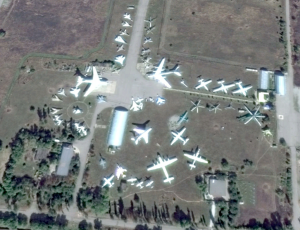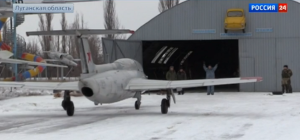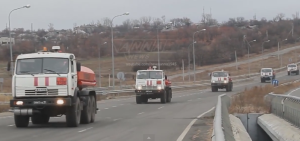Reports of the establishment of a Russian invasion army’s air force being the making are circulating since several weeks now, but today (January 18, 2015) Russian news channel “Russia-24” posted first footage of what is described as the “air force of the People’s Republic of Luhansk”. This article answers the main questions about that new air force and assesses its threat to Ukrainian towns and military infrastructure now and in the future.
1. Where is the air force’s base located?
Footage can be traced back the the former training airfield of the Voroshilovgrad Air Navigators Academy, part of the 17th air army of the Soviet Union. The base is located just south east of Luhansk city, some 12 km north of Luhansk’s “new” airport which was entirely destroyed during the Russian invasion in late August and early September.
The airfield was established in the 1940s and used to train pilots on L-29 until 1967. After that it was used as an air academy, teaching “the art of flying” on the ground. After the fall of the Soviet Union, the academy was operated further by Ukraine until 1997 when it was closed. Since then, the “Luhansk Aerodrome” serves as a military aircraft museum and is officially listed on travel guides into the region. It contains more than 50 planes and helicopters, including small fighter jets up to large Il-76 freighter aircraft. Until recently, details on the museum were available via the official homepage http://avia-museum.lg.ua/ but it is out of order since several months. Now we know why.
2. What airplanes does the air force consist of?
According to Russia-24, the air force consists of “several L-29 trainer aircraft, several Su-25 as well as helicopters of various modifications”. However, footage only shows one seemingly operational L-29 Delfín (NATO reporting name “Maya”), maneuvering on the airfield. It is not seen in the air in the available footage. However, it can be assumed that it is fully operational, seeing its instruments remastered and the entire aircraft in a good shape. At the same time this jet was build between 1961 and 1967 and used until ’67 for training missions at the “Air Navigators Academy”.
No other planes “in active service” are shown while one interesting report some days before the official publication of the article and footage said one more Su-25 is currently remastered in a hangar of the air field. Furthermore, footage shows the operational L-29 being driven into one of the hangars to save it from the weather (and possibly feared Ukrainian strikes?!).
No operational helicopters nor attempts to revive them are portrayed in the Russian media footage. So in conclusion it is fair to assume that there is currently only one active aircraft in the air force of the “People’s Republic of Luhansk” with one more being remastered at the moments and possibly ready to fly soon.
3. Has Russia its hands in it?
Of course. Several aspects serve as strong indication for that.
First, the news report claims that there is sufficient “fuel delivered to the airfield” and there is only one source of the needed fuel as neither the “LC” nor the “DNR” has aircraft fuel at its disposal. All possible reserves of it have been used by the Ukrainian air force or destroyed around Donetsk and Luhansk airports in recent fighting.
Second, it is natural that to fly airplanes, you need pilots. The article refers to them as “volunteers who received flight training in the Soviet time”. This clarification is interesting as it raises the question why these pilots have not been active during the last 25 years and what they have done since then. Also the – possibly desired – narrative of “former Ukrainian pilots” or “Ukrainian volunteers” is not used, but the only reference is given to the CCCP. One of the pilots is named as Aram Avakian, however his origin remains unknown so far.
4. Are there any other working air bases in Russian-occupied Donbas?
Yes. On October 8, news appeared that the small Tarasivka air field had been revived by Russian invasion forces. One of the two Yak-52 there-stationed could be seen flying over the field with the first ever message of being “Nororossiya’s new air force”.
In occupied Luhansk region, no other smaller air fields are know. A big question mark remains over the official airport of Luhansk, some 20 km south of the city. While latest available satellite pictures show the airport widely destroyed and its runway blocked on August 31, it – if repaired – would be the first choice for Russian reinforcements landing and possible fighter jets departing. However the question of eventual Russian efforts in this regard can not be answered before either new satellite pictures or footage from the area comes up. At the same time, there are no known airfields operational or aircraft flying over the territory of the Donetsk region, despite the existence of some smaller strips. Donetsk airport remains in the focus of fighting and the runway seems to be badly damaged, making air traffic impossible – even in the case of a real ceasefire – for months, no matter who controls it.
5 How big is the current(!) threat of the Russian invasion army’s air force
Right now, the threat is not that big. If the conclusions from the latest footage are correct, there is curently one Yak-52 and one L-29 operational in the “LC’s” air force, which is not very concerning from a military point of view. Both aircraft are unarmed, so even if Russia would deliver arms to upgrade them, it would need some more work to refurbish them in a way that would make them able to use these weapon systems. Hence, the Russian report’s claim that the currently established “LC” “Air support [is] a very important thing.” can be regarded as an empty phrase.
6. How is the prospect?
However this “low risk assessment” for the very current situation can change within hours or days and the foundation of a dangerous – fit for fatal action – air force was already or is being established at the very moment. Russian invaders’ would not publish news of such crucial development if they didn’t know how to use and exploit them.
At the one hand, the Russian army was – with very few exceptions – not willing to deploy its own air force inside Ukraine or supply “rebels” (its invasion forces) with used fighter jets or helicopters like the Mil Mi-24 which would make a big advantage for them in the battle for Donbas.
At the other hand, the current report opens all doors for such support in the future. The Russia-24 article mentions at very first “The [50+ year old] runway is cleared”, being available for landings and take offs from now on. This is a sign for possible outside help, being expected at any point in the future. Moreover, the article – and the “militants” at the base – claim that “several” Su-25 are made over right now. True or not, this claim lays the foundation of Su-25 indeed popping up at the now active air base at some point, either really refurbished or driven in by trucks from Russia in parts and being fully assembled at the base. Under this pretext another possibility is that Russian air force aircraft will simply invade from Russian bases, now that th “LC” has an air force, and attack Ukrainian targets, disguised as the “LC air force”. These Sukhoi ground attack fighter jets – if present at the base as already announced today – would be a real challenge and a possible game changer in the war for Donbas. Therefore today’s announcement of the “establishment of the Luhansk People’s Republic air force” should be taken as seriously as possible and military consequences for such appearance in the near future should be drawn already today.








A hypothetical few semi-operational Su-25s would not be a “game changer” in the scope of this conflict. I suggest reading up on the logistics of modern warfare (including airpower), because despite your excellent geolocation work it sounds like you might not be grasping the scale of this war nor how opposing forces actually effect each other. Just my 2 cents.
Well, sadly you didn’t get my point. Saying, “we have several Su-25” could lead to a sheer unlimited stock from Russian depots.
But it just doesn’t work that way.
Supporting an *effective* air campaign requires an infrastructure – both in material and personnel/institutions that simply doesn’t exist there. It’s not as simple as Russia flying in a formation of planes and some pilots. If it ever comes to pass that the DNR has a “game-changing” airforce as you put it, by its very own requirements it would have to come alongside Russian escalations that would make the airforce itself moot: i.e. it’d be part & parcel of full-scale and open Russian warfare & occupation (which despite the hashtags hasn’t remotely happened yet).
You’re a smart guy and you’re doing some interesting stuff, but you seem to often make assumptions about the military aspects that don’t jive with how wars are actually conducted. Since you don’t have firsthand military experience (this is obvious), I highly recommend investing a large amount of time with books about 20th (and 21st) century conflict, especially logistic and strategic side of things. Us civvies, raised on a steady diet of movies, novels, and video games with their small-scale heroics, often have a hard time understanding the true scale of most conflicts and what it takes to fight them.
Robert,
You’re a smart guy, but there’s no need to be condescending with your straw-man arguments. The faux airbase serves the following purpose: making the next slice of the soviet “salami tactics”, providing plausible deniability for operations conducted from an actual Russian airbase Millerovo 50 miles away, while claiming thats all done with the few museum carcasses brought to life, operating from a grass strip.
That’s exactly what was happening during the initial influx of tanks and heavy artillery.
It really wasn’t my intent to be condescending or trolling. Apologies if that’s how it came across. Just constructive criticism, and more of an overall bent – the author has repeatedly made statements that show an ignorance of logistics or the realities of how warfare’s conducted (moreso on their Twitter account), sometimes posts that lean towards the shrill-jumping-to-conclusions side of things. If this was the first time I wouldn’t have mentioned it.
The author says: “True or not, this claim lays the foundation of Su-25 indeed popping up at the now active air base at some point, either really refurbished or driven in by trucks from Russia in parts and being fully assembled at the base. These Sukhoi ground attack fighter jets – if present at the base as already announced today – would be a real challenge and a possible game changer in the war for Donbas.”
There’s no mention in the article of “salami tactics”. He’s simply referring to Russians importing larger amounts of jets than the separatists already possess, and the airbase suddenly being able to support a sustained air campaign.
ok, sorry, I didn’t make that clear enough in the article. Imo, the whole “we have several of this and several of that but won’t show you today” is exactly what I consider the “salami tactic” you talk of. So it was my inention to show another “small step by step” escalation, this time in the aerial military sector. Not good, I didn’t make that clear.
Thanks for your replies!
1. Aram Avakian should be of Armenian origin, but we will not be able to find out his citizenship.
2. The main idea of that “announcement” (about LNR Air Force) is to send in Russian aircraft painted in LNR colors with Russian pilots and to attack Ukrainian troops, as they did it during the Korean war in 1950s.
3. This indicates that Russia is preparing to an offensive and a war on a larger scale.
Autor of this article has a point saying that everything that has appeared in a form of ,,a little bit” in mean time got a pretty large scale. But if you look from the other (Kiev) side, a large amount of military non-lethal aid , eventualy appeared at Doneck Airport as (guess now) very-lethal. This is a new form of modern warfare and it will continue to unroll in that direction, hardly getting a point of large scale Russia – NATO confrontation.
Could you, please, name this mysterious “non-lethal aid, which appeared to be very-lethal”?
I belive that you can remember a few aircraft (cargo type) that have landed in various airfields with ,,humanitar” aid for Ukraine army, and then photo evidences showed a lot of NATO small-arms, snipers and other lethal wepons. I think that should be enough.
Pingback: Russia prepares the ground for the use of its air force against Ukraine | Info-News
It just makes no sense at all, after sitting there for so many years (especially outside) it will have a lot of broken seals, dried out rubbers, corrosion etc… To make it airworthy again you would have to take it apart completely.
I cannot imagine you can just put pressure on the system and start moving.
Also most aircraft at a museum don’t contain an engine because it is not needed and a very expensive part, sometimes even not allowed to be photographed or be in civilian ownership.
Reblogged this on Commentaria.